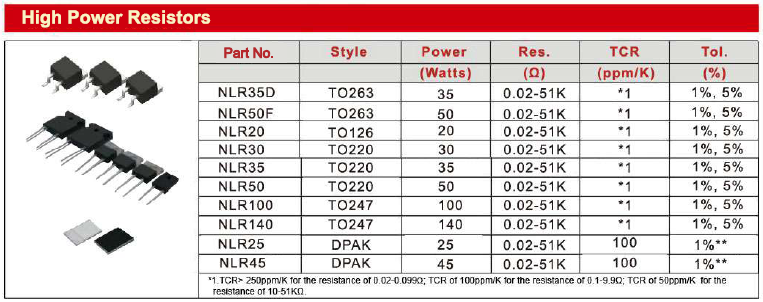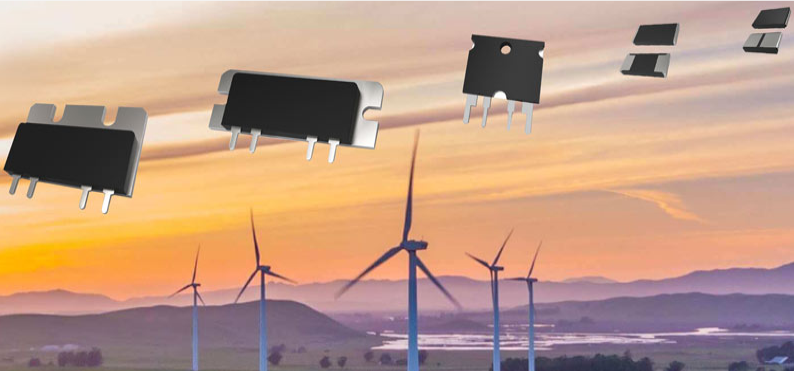Position:Home » Technical Articles
Considering Power Resistors for Renewable Applications
Writer:Microhm Page View:Date:2019-11-04
In recent years, renewable energy options have become much more efficient and feasible. This has led to a large adoption of these applications, an especially poignant point in the face of current environmental issues. However, just like all other power generation methods these applications require resistors. Microhm Electronics provide various power resistors for this application, such as TO-220 type, TO-247 type, NUAL series, MMS series and more.
With the recent news that E.ON UK plans to power more than 3.3 million customers with 100% renewable electricity as standard, it is clear that renewable energy is starting to take the main stage and the growth of the sector is set to continue. This is reaffirmed by public perception, as a YouGov survey found that more than three in five Britons currently on a standard electricity deal would switch to a renewable electricity supplier if the price was reasonable.

Although embracing renewables is great for the environment, it does face its own set of challenges. Each source of renewable energy is dependent on the environment around it, meaning that production can suddenly soar and require the system to be capable of dealing with a sudden influx of power. For example, wind turbines are generally connected to the distribution network through step-up transformers. When these are energised, high inrush currents occur. These currents cause overvoltages on the distribution network, likely damaging equipment upstream.
Issues like these can be remedied by using technologies such as pre-insertion resistor (PIR) in the circuits. PIRs are a three-phase resistor, insulated for the full system voltage, typically 33kV and fitted with isolating devices as required. PIRs have a high thermal mass allowing them to absorb energy from high inrushes while still being compact enough to fit efficiently in a transformer substation.

These problems also extend to solar power. For example, when installing new solar panels or disconnecting existing installations from the grid for maintenance, the panels continue generating electricity. As a result, discharging this excess energy must be prioritised to prevent damage occurring to the solar panel system. Resistors are crucial in safely dispersing this excess energy.
Dummy loads resistors transfer the excess energy into heat and release it into the environment to prevent the solar panel from overloading. Once in operation many solar farms equip panels with small electric motors to maintain the cells at the optimum angle compared to the sun for the longest amount time, in order to maximise energy generation. As such, they require braking systems to ensure they are at the correct angle.
Keywords:Power Resist
Latest News
- Resistor's role in measuring and correcting LED,,,
- Single through-hole resistors' characteristics ,,,
- Why shunt resistors for current sense applicati,,,
- Metal-film resistors with small size, high resi,,,
- 36W High-Current Shunt Resistors MMS8420,,,
- 1W Surface Mount Resistor MPR1206,,,
- An Overview of Microhm Electronics' Resistor Pr,,,
- More anti-sulfur resistors used in harsh envir,,,
- Resistance changes with temperature,,,
- 140W TO247 High Power Heatsinkable Resistor,,,
- MMS5930 is ideal for current sensing in industr,,,
- Shunt resistors selection for engineers' design,,,
- Considerations for choosing precision resistors,,,
- Ceramic Encased Cement Resistors NWH Series for,,,
- Resistors for Passive Balancing in Battery-Pow,,,
Hot Articles
- Microhm will take part in 10th Automotive World,,,
- Thanks for Visiting Microhm's Booth E5-5706 in ,,,
- Resistors in Short Supply: Blame Cars,,,
- New lunch: High Power Precision Shunt Resistor,,,,
- How to Test a Resistor,,,
- Innovative Technology, Future Electric: Electri,,,
- What is Precision Resistors?,,,
- SMD Resistors Sizes and Packages,,,
- The Construction and Features of Metal Film Res,,,
- What is a TO-220 Resisor?,,,
- Hot Selling Products: Precision Shunt Resistors,,,
- How to Calculate the Equivalent Resistance Valu,,,
- What is a Fixed Resistor?,,,
- Resistors in LED Circuits,,,
- Resistors Types and Materials Overview,,,
Resistance applications
- The Four Important Functions of Alloy Resistors,,,
- Shunt Resistor MMS8420 for High Current Stable ,,,
- Miniature future for passive electronic compone,,,
- Why Zero-Ohm Resistors?,,,
- Carbon Film Resistors' Features and Application,,,
- Heater Blower Motor Resistor in Air Conditioner,,,
- Precision Resistors' Construction and TCR,,,
- Industrial Roberts Applied to Solar Photovoltai,,,
- Select the Right Resistor for Harmonic Filterin,,,
- The Main Application for High Precision and Low,,,
- Urbanization Development Bringing the Transform,,,
- Surface Mount Resistor's Size and Package ,,,
- BMS for New Energy Vehicle,,,
- The Measurement Accuracy of Automotive Shunt is,,,
- Difference Between High Precision Resistors and,,,
